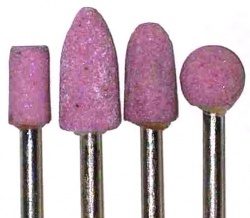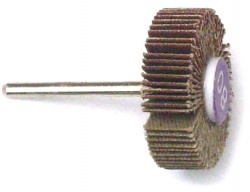Die grinder
Die Grinders and Rotary Tools are small high speed rotary power tool, the latter being the smaller lighter version sometimes used in diy. They are often referred to as Dremel (a popular brand), rotary tool or hobby tool. They take an array of tools with 1/8" shank (3.17mm), and typically upto 1.5" diameter.
Tools
Rotary tools use a 1/8" collet rather than a Jacobs chuck, so all tools need a 1/8" diameter shaft (3.17mm).
Collets
- Available in a few other sizes
- Enables use of other drill bit sizes
- The set on the right covers 1/16" to 1/8"
Drill bit
- Only 1/8" (3.17mm) bits fit
- Other size collets are available, enabling a few other drill bit sizes
- Around 30,000 rpm means they drill far faster than mains or cordless drills
- Thin drill bits are very weak, sideways force or movement should be carefully avoided
- Don't be tempted to try solid carbide bits in die grinders, in small sizes they are unsuitable and unsafe for handheld tools.
- Its possible, upto a point, to grind 1/8" bits down to get smaller hole sizes, or to wrap a smaller bit with wire to get it to a 3.17mm shank
- Larger holes can be drilled in plastic using a different method
Grind stones
- Various shapes, & a few compounds & grades.
- Aluminium oxide is used for most grinding stones, and isn't very good at grinding steel.
- Alox stones come in various light colours.
- Carbide stones are good for steel. These are dark grey, and several times the price of alox.
- Use depends on the material and shape of the bit
- Can be used for "frosting" / engraving slightly larger areas of glass than traditional engraving bits
Drilling with grind stone
Plastics can be drilled with a pointed cylindrical alox grind stone.
- Drilling occurs by both abrasion & melting
- Speed of cut is good once the stone warms up.
- No risk of cracking the plastic
- 1/4" holes drill easily & quickly
- Withdraw the tool without delay once it penetrates
- Makes a mess of the stone
Felt polishing pads
- Polishing metal, plastics,
- Use with polishing compound
- Used to create the circular swirl pattern finish sometimes used on metalwork
Screw mandrel
- These hold felt polishing pads
- The screw thread tip just screws into the felt pad
Cutoff discs
- Extremely weak and break eagerly. Expect to use a few even for a small job
- Take care to hold the grinder very steady, or disc will break impracticably quickly
- Reinforced cutting discs are tougher, but still not strong
- Slow cutting compared to an angle grinder
- The very narrow kerf of a fraction of a mm is occasionally useful
- Half worn discs can be used for access into very tight places
Sanding drum
- Usually alox grit belts
- Loosen the end screw to release the belt
Rasps
- High speed coarse cutters
- Fast shaping of soft metals, plastics, wood etc
- Don't try to use on harder materials such as steel or masonry
Flap wheel
- Sanding flaps
- For sanding non-flat surfaces
- Normally alox abrasive
Spiral saw
- 1/8" spiral saw bits can be used in die grinders
- Sideways cutting with a thin weak bit isn't the best combination
- Limited uses. Best with thin and soft materials eg plastics
Sanding discs
- Sandpaper discs are used with a rubber backing pad
- Typically weak and fine grit, making progress slow
- Not really suitable for stock removal sanding
Cotton polishing wheel
- Polishing
- Used with abrasive paste, rouge etc
Diamond coated engraving bits
- For engraving glass
- Security marks hard surfaces
- Postcode and often house number are the usual info engraved
- Assorted shapes
Diamond cutoff disc
- Not fragile
Metal wire wheels
- For removing rust, corrosion, scale & paint
- very effective
- Full size angle grinder wire wheels are much quicker for most work
- Can cause rust staining if used on concrete
- Raises grain in wood
- Brass wire wheels remove rust, paint etc without damaging steel workpieces
Nylon brush wheel
- Cleaning
- Removal of soft materials
- Removal of loose paint
- Plastic bristles mean it won't damage a much wider range of workpiece materials compared to wire wheels
- Stripping copper corrosion
- Wax polishing
Island cutter
http://www.diamond-drill-bit-and-tool.com/Diamond-Drill/DD2.shtml
Abrasive types
Tools use the following abrasives
Aluminium oxide
- The most common abrasive
- Medium performance
- Slow going on steel
- Not effective on hard steel
- Come in a range of colours, mostly pink, also white and assorted light colours
- Occasionally grey tools are alox rather than carbide
Carbide
- Silicon carbide is a much more effective abrasive
- Several times the price
- Grey
- Cuts hardened steel nicely
Sand
- Not very common
- Low performance
- Can be described as silicon oxide or dioxide
Diamond
- The planet's best abrasive, can cut anything bar another diamond
- ...if it stays attached to the tool, and is coarser than fine dust
- Too often neither is the case
Steel
- Used as the cutting edge in rasps
- Good for plastics, blunt rapidly on anything harder
Brass
Rust & paint removal
Nylon
Cleaning mainly
Tool Maintenance
Grinding stones can clog with metal. This can be removed either by a wirebrush, a coarse abrasive or a spiked wheel.
When grinding soft metals such as aluminium and copper, clogging can be a real problem. Rubbing the disc or stone firmly with chalk first can reduce clogging.
Performance
Linear speed of a 1" 30,000 rpm tool is around 2/3 of that of a 4.5" 11,000 rpm angle grinder tool. Also angle grinder discs & brushes are much more robust. So more speed and force are available from an angle grinder than a rotary tool.
The advantage of these grinders lies in their tiny size, which enables access in restricted spaces, and makes fine work with miniature tools practical.
They are also generally much quieter than angle grinders, occaionally an advantage.
Finally more types of tool are available for these than angle grinders.
Usefulness
Personal experiences:
- I rarely use mine, but when I do, nothing else will do.
- I last used one for cutting out some bearings. I don't know any other tool that could have done the job.
- They can be used for cutting pipes in awkward places.
- They de-rust old tools well
- I use mine with a small grinding bit to trim my toenails. The tiny little grinders the cosmetic firms sell for this purpose are utterly useless, but the Dremel is first rate!
Speed
These tools operate at extremely high rotational speed, and one should check that the tools used are rated for the speed of the machine. There are tools available rated at below typical machine speeds, and these should not be used above their rated speed on safety grounds.
Reducing speed
Some machines have variable speed for lower rated speed tools.
For machines with no speed control there are workarounds for speed reduction, though they're far from ideal. They all rely on the fact that speed is proportional to voltage. This is true for both mains and low voltage machines.
- Running the tool off a 110v transformer gives a max speed of 110/240 x the usual run speed
- Low voltage tools can be run off a supply of lower voltage to reduce speed.
- If no better option is to hand, running a lightbulb in series with the grinder reduces voltage and speed.
- A multimeter is used to measure the offload voltage and thus calculate max speed. The downside of this arrangement is that as the tool is loaded its speed will reduce at a greater than usual rate as load increases.
See Droppers for more information
Safety
Explosive breakage of the cutting/grinding tool at very high speed can be an issue. Running tools over rated speed should be avoided.
Cutting discs break extremely easily.
Wire brushes are prone to shedding bristles. These shed bristles come off at high speed, often sharp point first. Some wire brushes have a reduced speed rating.
Eye protection shold be used, and one should stay out of the plane of spin of the tool.
Catching a spinning tool on something can yank the machine. The machine should be held firmly, hands kept out of the way of the tool, and force on the workpiece should be kept light.
Tools that cause vibration should be retired. These are much more liable to fail dangerously in use. They also put high stresses on machine bearings causing premature failure.
See Also
- Angle Grinder Discs
- Make a die grinder drill press
- Wiki Contents
- Wiki Subject Categories















